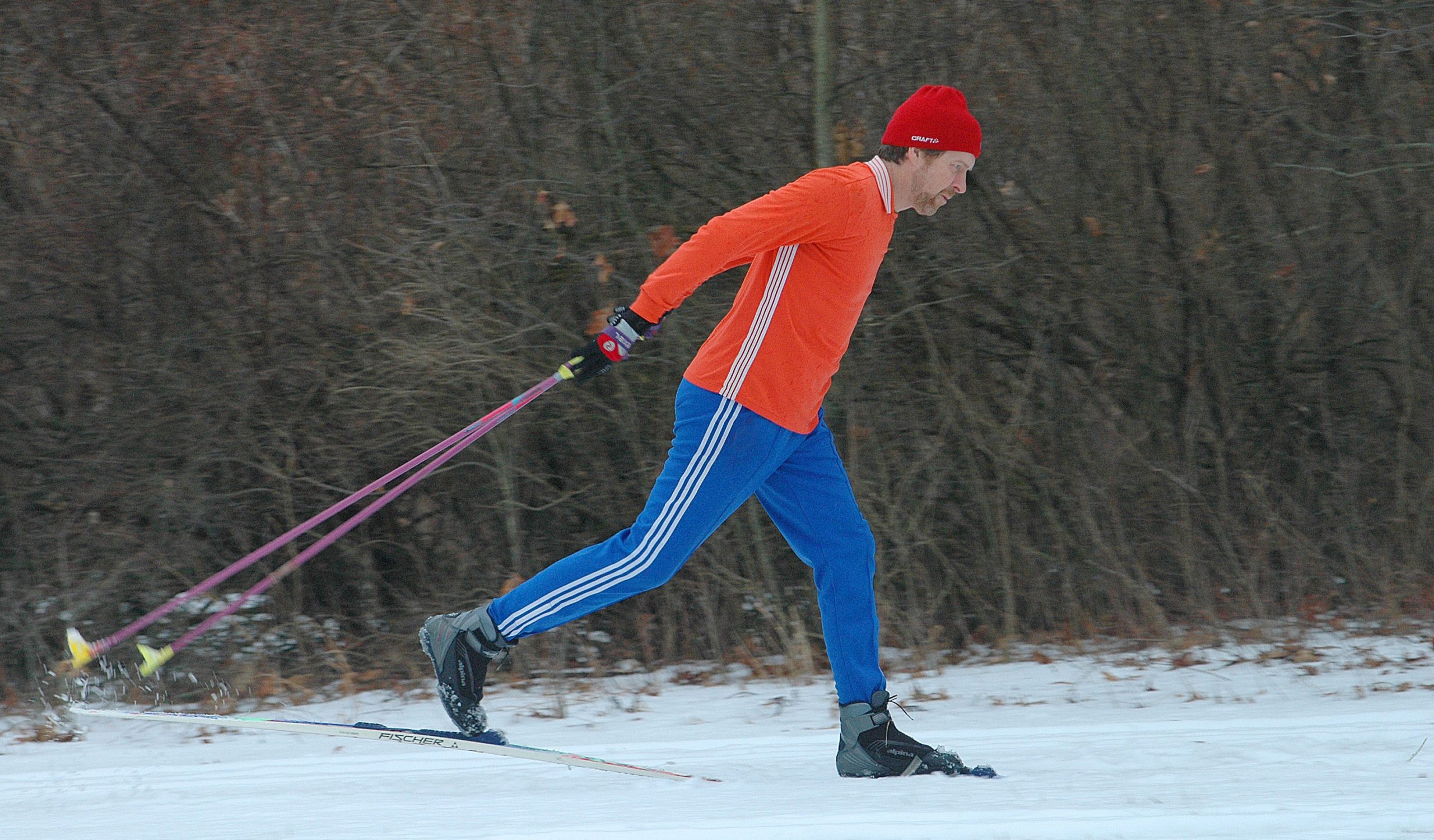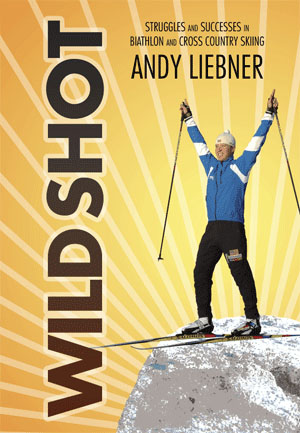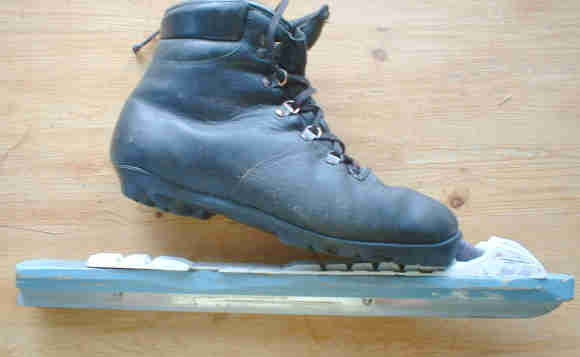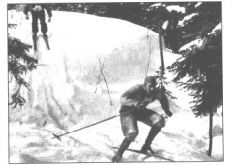More Photos Below!Gallery
[NOW WITH PICS! 1/23/12] Here’s a story of mine that “Silent Sports” ran last winter. It’s a doozy! With lots of pics. Here’s a link to the story on their website (https://www.silentsports.net/crosscountryskiing/117241278.html), but there aren’t any pics. I’ll run the pics after the text.
Singletrack Fever: Skills to Return to our Roots
Picture you and your friends skiing a backwoods trail with a few inches of fresh snow on top. You’re all getting nice float and glide from your touring skis. Your rucksack has a picnic stashed inside.
How are you skiing?
I’ll bet half the time you’re using techniques that aren’t taught anywhere these days. And it’s likely you would be told you’re doing it all wrong.
But there’s a good chance your moves can be found in old books from the wood ski era. By continuing and reviving these marvelous old moves, an old sport is reborn.
The difference between how we once skied, how we do ski and how we’re told we should ski is fascinating to me. I think that by returning to the past we can take cross-country skiing to a fresh new level and remove obstacles holding it back.
Consider mountain biking on singletrack and how it differs from road riding on wide smooth pavement. Road and mountain biking require different techniques, and gear, yet each has so much to offer, as the whole bike world has come to appreciate since mountain biking burst on the scene.
A fully developed ski scene covers these same bases. There’s a groomed “paved” side and a woodsy side – both deserving equal attention. Yet nowadays, serious Nordic skiers tend to neglect their singletrack roots. Mountain biking interrupted – and revived – the fading bike racing scene, which had been limited to conservative road racing, but groomed skiing developed straight out of wilder trail action.
Today groomed racing technique gets all the attention, but what’s “correct” is what works best in a given situation. Most folks are skiing on common homestyle trails and race only occasionally, if that. Ungroomed skiing is what has the potential of attracting and benefiting everyday skiers.
Marvelous no-fee, raid-style racing on ungroomed trails is starting to catch on. It’s a low-key, high-skill, big fun blast. No micro-fussing over waxing, flex or base grinds. After five years of running our local raid on the epic Potawatomi Trail, no “real” ski racers have yet joined us fun-loving mountain bikers and yahoos.
Let’s also not overlook the ultra-low impact of cross-country singletrack. Skating needs a road-like lane that requires big machinery and an equally big budget to maintain. Meanwhile, hiking trails that are off-limits to mountain biking are open to the glide of ski touring.
I’ve studied Nordic skiing technique for decades and believe the touring side has been neglected. What’s amazing is that’s the most popular mode of cross-country skiing with the most potential for elaboration and growth.
I’d like to bring several relevant techniques to light, moves that I’ve never seen explained before, at least not very well. These are moves that can uplift our backcountry trail experiences. Some of these approaches may seem new or sound wrong until you see how sensible they are at the right times. You may be unaware that you already use these techniques.
I’ll argue that what I’m about to describe has the potential to bolster the popularity of cross-country skiing by making it more accessible, appropriate and fun.
Time for a Change!
When was the last time Nordic skiing saw a significant change in technique, instruction and social impact? It was when skate skiing appeared on the scene and again when the “new skate” movement reared its head for awhile. The arrival of skating was embraced by some and scorned by others. I was an enthusiast before, during and after both revolutions. And I’m revved up once more.
This time the “new” moves are built around ski touring, which is more open to everyone and anywhere there’s snow. As we’ll see, these moves also have something to offer the groomed-trail, high-speed crowd as well.
I constantly marvel that touring is taken for granted in instructional media. I’ve studied nearly all of the cross-country skiing books published over the past 50 years, plus DVDs, videotapes and online videos. Touring technique is rarely mentioned. When it is, or when you read between the lines to find it, it’s equated with beginner skiing. It’s treated as part of a continuum that reaches its peak, not with optimized touring, but with racing. Yet, I’ve had such fun discovering the diverse richness that the touring mode actually offers. And I’m sure I’ve only scratched the surface.
Of course, official instruction and method is necessary. The moves and ideas here are only supplementary. Skiing skill is a continuum embracing all the styles, but there are branches on the skill tree, and touring can lead us to exciting places. (I must say I’m not certified by anybody, anyhow. I only suggest you give these notions a try.)
In the past decade, I’ve shifted from ski racing to everyday adventuring on local skied-in trails. This is partly because I moved close to hiking trails and away from groomed trails. I can transform a simple woodlot into an expert course in a few hours just by tossing dead sticks aside and skiing it in myself. The result is I’m having more fun, increasing my skill, getting great workouts and finding more challenge, variety and better scenery (as well as saving time and money) with homestyle skiing. It hasn’t hurt my racing on groomed courses either. Racing is still fun for me, and I keep my hand in it, but mostly I opt for free-form, wild-trail action instead.
Frankly, this describes what many other skiers enjoy. To them I’d like to pay it forward by providing some overdue how-to info.
A Stride for Touring
Upright classic, touring stride or delayed diagonal is the most common striding technique used by touring skiers. And it’s called a mistake by many ski instructors and authors.
Imagine yourself skiing a hiking trail and carrying a rucksack, nice and relaxed. Your torso is upright as you glide, looking around, enjoying the scenery. Are you following through far to the rear with your poling? Are you committing to each foot and getting high-hip, hang-time glide? No and no.
You have an upright posture so you can see, chat and remain relaxed as you carry your pack. How does one pole when tilted upright? You swing your straight arm well forward, plant your pole at an upright angle, then push. And stop at your hip. That’s full extension for an upright posture. Yes, you’re cheating by relying on your poles for stability. The ungroomed snow makes that a naturally smart idea.
Since you’re upright and you’re gliding down an imperfect trail, how are you kicking? Well, you pole and then, as your hand comes to a stop by your hip, you drop your hips a bit and give a kick with a bounce and a toe-off.
This means your kick is hugely delayed compared to how racers and instructors do it. Your foot doesn’t fly up, out and back, pointing way back down the trail. It kicks down then lifts up as it’s flung back, staying close to home, coming down about a foot behind your glide foot. This makes for a stable semi-telemark finishing position.
“Correct” diagonal tips you forward and tilts your head down. It’s not for sight-seeing, thus it’s astoundingly of little use for tour-skiers cruising along.
You’re breaking other rules, too. Your instructor will say that on flat terrain, you should double pole. If the snow is a bit slow or it’s slightly uphill, you should kick double pole. None of those rules meet the needs of touring skiers or, for that matter, mortals.
Honestly, how many everyday skiers keep the ab crunch of “proper” double poling or kick double poling going for very long? How about on a soft, uneven backyard trail with twists and little whoop-de-dos? Yet, the current scene tends to put doubt in learners’ minds if they’re not using the three main officially approved gears. But if the shoe doesn’t fit, they’ll vote with their feet.
So-called “correct” classic techniques use a forward tilt with bobbing compression plus an abandoned-type weight commitment – all of which is designed for super-fit skiers on firm, fast, groomed track and unsuitable for convivial sightseeing on home-style trails. This divergence of needs calls for diverging techniques if the popular touring side of the sport – the bedrock of Nordic culture – is to thrive.
Delayed-kick striding is often called “shuffling” by racer types, and sure, that’s what slow skiers often do. But advanced skiers also use it with good results when touring. Here we have another distinction that has been glossed over by a racer-oriented scene.
The touring stride is admittedly not good for uphills. It gives a late, short, rather weak kick, so you’ll slip before a hill gets very steep. That’s why it’s for the flats and for touring, not racing. Of course, all skiers need to commit to their skis and poles to optimize grip and glide for steep climbs or for when speed is needed. But when terrain is mellow, conditions are lively underfoot, when carrying a load or in need of working different muscles toward the end of a long day of skiing, there are other factors to consider than just grip and glide efficiency. In such cases, the delayed diagonal can be a dandy move of choice. Of course, many skiers do this already, instinctively.
Interestingly, the delayed kick in this common touring technique parallels the delayed kick variant of the V1 technique that midpack skate skiers use, especially in marathons, to optimize relaxation and enjoyment over mellow terrain.
A Doublepole for Everyone, Everywhere
How often is “correct” double poling suitable for ski touring? I’d say seldom. How often is it used in racing? Most of the time. Quite a contrast, eh? Yet, we’re talking about the same classic side of the sport. Why does it play out that way? Is it because tourists are weak shufflers and racers are strong enough to double pole?
But watch a racer hit a backcountry trail covered by a few inches of fresh snow and see how much they double pole. No, fitness is not the difference, nor is advanced skill.
Touring involves uneven trails of varying softness and quick changes in incline, decline and direction. Advanced performance when touring involves a number of fun solutions, but it doesn’t include much what’s widely considered correct double poling.
“Correct” double poling requires throwing one’s center of gravity forward, crunching the torso and committing to gliding on two feet side-by-side.
Touring requires you to keep an internal center of gravity, like you need when downhill skiing through steep powder. You don’t throw your weight out onto your poles so much. What’s more, in a standard kick double pole you throw your weight out even more than when double poling.
Try the striding double pole instead. To do it you don’t throw your weight anywhere when you kick, and when you pole you don’t drop your torso nearly as much as when kick double poling. Give a kick to start and throw your arms forward as usual but with less gusto, then double pole with a tiny crunch. Then, when your hands pass your hips, you kick again. Thus you kick twice for each poling cycle. You’re striding as in regular diagonal, but only poling on one side and with both poles.
This is a great way to get in some double poling when the trail is soft and changing underfoot. The striding double pole technique breaks the power phase into more pieces while keeping balance internal. It’s also better for climbing than kick double poling.
As with the touring stride, many touring skiers already do the striding double pole. Since the move isn’t taught anywhere, I’ve had several fit, gung-ho new ski tourers express embarrassment for doing this “probably all wrong” move. I laugh and tell them they’re skiing just fine.
Also, it is actually included in military winter skills manuals — though how much it is taught, I have no idea. The military method emphasizes a “weak side” stride. I often do this, too: I jump hard off my non-poling leg and do leap out and fall onto my poles, then my poling-leg stride ends up weaker. It’s kind of “galumphing,” but it works for uphills quite nicely without being tiring.
Soon after I started writing about the striding double pole online, Dale Niggemann, of CAT Ski fame, posted about it independently on his blog. He declared that he had found a way to skate ski in diagonal tracks. And he said he trained for this kind of skating with his classic-style dry-land CAT Skis. He calls his new move the Cat 1, since it mirrors the V1 (except I find that the best “weak side” is opposite of the V1 weak side — hmmm!).
Niggemann also found that you can do the V1A or Open Field Skate with classic skis, which he calls the C1A. He says testing is incomplete, but he won a classic race using these moves without breaking any rules. He also won a skate race after only training with these in-track moves. Amazing.
Skidaddle — a new kind of Herringbone
It’s common when skiing hiking trails to encounter eroded uphills with obstacles where the stride and herringbone aren’t the only or even main tools you need. You need a special new trick that’s not mentioned or taught anywhere but here. (Dang! Where do we keep coming up with these finds? Why, the Real World, and nowhere else!)
You need a compact side scamper, or “skidaddle” as I’ve been calling it. And if you don’t practice it, you won’t do it well. If done right it can be fast and easy. Done wrong, it’s slow or worse. In short, in gullies a herringbone doesn’t work AT ALL, but the “skidaddle” works great.
It’s like striding side-stepping. You rotate both skis enough to one side to get grip and compactly tread your way up. Since it’s often on a slope that tapers to the center of the track in addition to back downhill the best ski angle isn’t obvious: rotate ’em a bit farther than you think is best — they should almost slope down toward the gully-middle. One leg and pole lead the way. Take small leap/steps, keeping skis and poles low to the ground. Don’t reach up far otherwise you lose all hustle and start laborious side-WALKING/straining/floundering. Don’t step up too far, either. Keep a forward couch-tilt with ankle-flex. And don’t go too hard — it’s easy to go under. (I wonder if compactness is also key to herringbone?)
True trail skiing uphills often twist around, with several features, and commonly include roots and shelves at various angles. So you’ll want to continuously change what you’re doing if you want smooth flow up such a hill. You’ll stride a bit, herringbone, skidaddle — sometimes jumping to clear an obstacle while using your poles to “stick” hold your position. Heads-up! Look ahead and see which side of the trail slopes best, works best with root angles, drops, etc. Doing all this without using too much energy is part of the joy of trail skiing. Keep practicing!
A fit young guy joined us in a rugged trail race and did really well until his ski broke in half (he did well enough after that, too, since the base didn’t shear). The main thing is he said we were killing him on the uphills. He knew about the skidaddle but it was baffling him. He said he tried doing it but we’d still leave him in the dust even though we were just chugging along in “long steady” mode. So there’s a knack to it!
Pendulum Poling — for Group Fun
Back in the wood ski days, the skis, poles and boots were heavier and trails were much less likely to be groomed. That hasn’t entirely changed. Touring skis and poles are heavier than racing skis, and there are still a lot of wood skis in play. When skiing home-style trails, you need more options for the wide variety of conditions encountered, so let’s work to expand our moves to fit our needs. It’s a win-win all around.
Sometimes people say cross-country skiing isn’t as popular as it could be because it’s too complicated. I doubt that. Do skateboarding and snowboarding have too many moves? People love variety. The real problem is that what’s taught and sold doesn’t fit new skiers’ needs well enough.
Skiers are often out there with a passel of friends rather than racing. So don’t they need to learn how to ski in close quarters just like racers? They also want to keep their flow, yet not run up on each other’s tails.
An easy way do this is by pendulum poling.
A skier gliding up behind another wants to slow down without losing their rhythm. They can do this by skipping a pole plant on one or both sides while swinging the basket forward but pumping the hand back toward the chest. By the time the pole swings back, it’s time to pole again. It lets you skip a poling (and maybe slow down a bit) while keeping your same rhythm.
I use this move a lot when kick double poling on a flat touring trail amidst a group of friends. Our speeds will tend to diverge as we flow over little humps. By using pendulum poling, I keep my rhythm and my gap constant to the skier ahead of me.
The Swing-Tail Turn
This move is taught, but not praised enough for its coolness. (Actually, it’s not taught enough, either.) It’s the standard diagonal stride turn.
You have your skate turn, best for fast or downhill turns; your step turn, a shuffle from ski to ski around the turn; and skidding turns done at higher speeds. Groomed trails are mostly wide open or fast enough that these moves cover your bases most of the time. But we really shouldn’t forget the striding turn.
Keep your tips in the track or just point them where you want to go if you don’t have much track, then swing your tails out as you stride and glide around the turn. You can take full strides and swing your tails a lot without worrying about crossing your tips.
It seems that even some ski racers don’t know how to ski fast around a narrowly tracked turn or uphill corner. Because I train on singletrack and am old school, I’m able to gain on others in these situations. Keeping a swinging flow going through corners saves time and energy and adds joy. Mountain bike singletrack lovers know and cherish this flow. It’s time for Nordic skiers to catch on.
This is another move that comes from the wood ski days when gear was heavier and it was best to leave the ski tips on the ground and pick up only as much ski as you had to get around the corner. It’s a delightful move. Do it as often as you can!
The Traction Drop
This isn’t a new technique but something many skiers already do without knowing it. When you’re skiing along and suddenly encounter a problematic portion of trail midstride, drop. Lower yourself a couple of inches. Let your hips sink. Flex your knees and ankles more. Drop the hands, too. This instantly gives a skier more options for dealing with a dicey situation.
Elite racers do it, dropping their hips the instant they feel their grip slipping. It gives a slightly longer, gentler kick, giving a better chance of keeping grip.
Touring skiers, skiing up even a gentle hill, can suddenly encounter inches of soft snow depth. That’s a point at which to drop. On flats when skis start to wallow and slip, drop. The move preserves flow if not speed. Generally, when you encounter loose conditions or bad grip, go low before changing anything else.
Follow the Fun!
So, why do I think it’s good that new techniques are emerging for ski touring? Because it’s where the fun is. And where the people are.
Home-style skiing opportunities are nearby, simple, friendly, sustainable, green and cheap. And the skills it calls for can be both expanded and refined to increase one’s satisfaction. What’s not to love?
Fear of liability seems to have led ski trail developers to remove a lot of the fun. We used to enjoy banked corners, multiple roller coaster drops and pre-jump airtime. But perhaps times are changing back. Today a growing number of Alpine resorts offer terrain parks that would’ve been banned in the ’80s. Maybe ski trail designers will also start offering tricky double-black diamond cross-country courses to bring on (and bring back) the thrill factor.
The telemark community has seized onto the potential of backcountry skiing. Many tele skis today are produced with no-wax bases to satisfy this new demand. Equipment makers experiment with ski lengths, widths and flex patterns, boots and poles to meet these new needs. Friends head into the hinterlands, find a glade, shred powder, then make their own uptrack – maybe stashing a few beers at the switchbacks. Pure fun with zero overhead. Lift-served resorts with groomed trails have no lock on freeheelers.
Since vertical enthusiasts also embrace the glory of backcountry skiing, I’m thinking the touring mile striders can’t be far behind. Will the movers and shakers behind the touring scene respond to what’s really happening out there on the trails?
Adventure racing and trail running have both appeared – and exploded – since the last big innovation in Nordic skiing. And skiers fare well in those sports, too. But those sports have something to teach cross-country skiers. Adventure racing and trail running are built around challenging, ad-hoc courses. Challenge, risk, surprise and thrill are their game. Do they require tidy trail grooming? Forget it. Narrow, twisty and treacherous is the new cool. It’s time for trail skiing to catch the vibe.
The jib ski was an attempt to give folks a way to trick around on groomed trails. Midlength skis now let us nimbly bounce down the trickiest of descents. What about a ski that gives good glide in deep snow on two-track trails? Perhaps someone could import the Finnish forest-type 250 cm soft-tip skis.
So let the examples of the snowboarders, freeheelers, mountain bikers and other trail freaks lead the way to better days for trail skiers. Innovations will soon follow. Who knows where it will all lead if we just set ourselves free. We just need to push ahead, watch what folks are already doing, and stick to our roots.
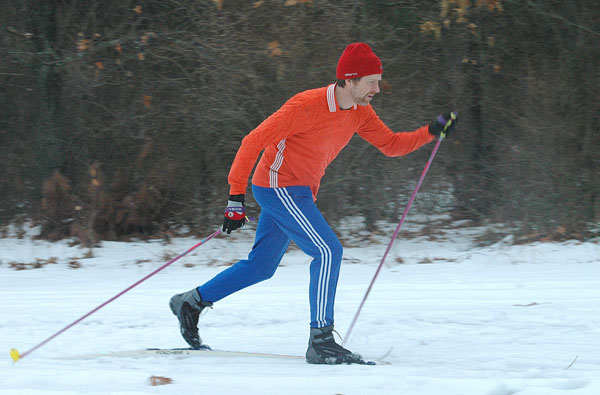
Drop for grip!
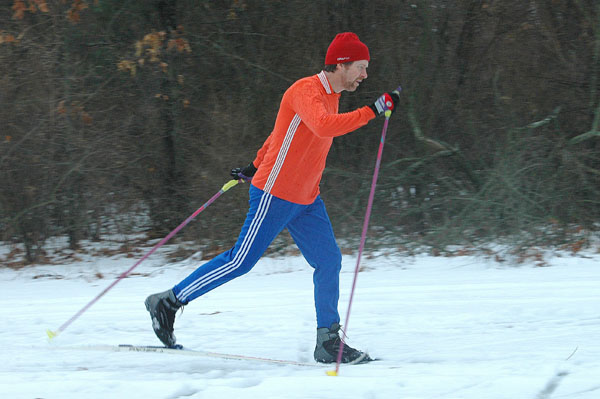
Feel a slip?
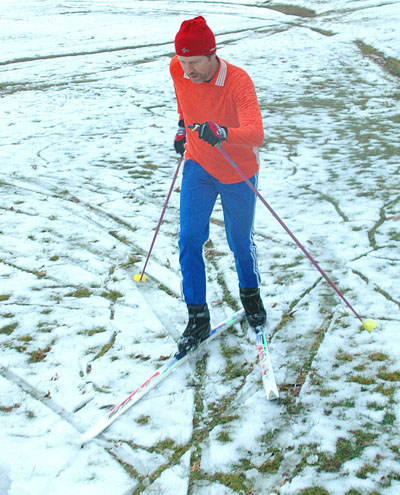
turn 4
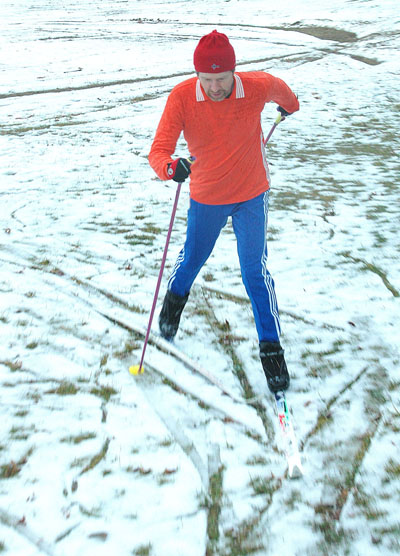
turn 3
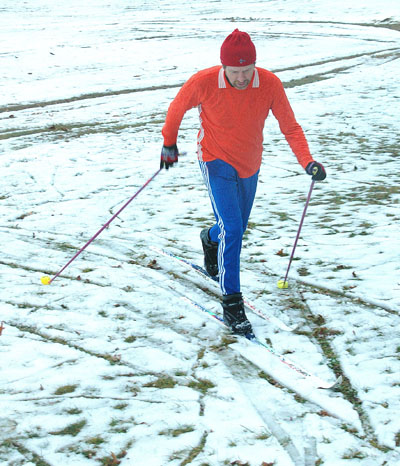
turn 2
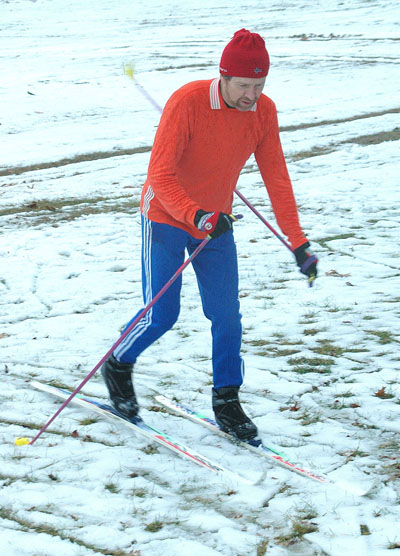
The diagonal “swing tail” turn!
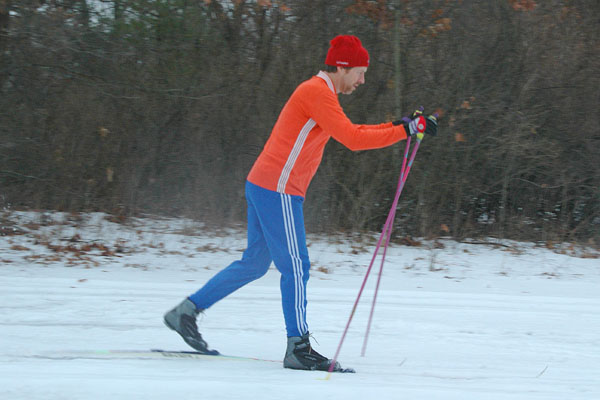
pen 5
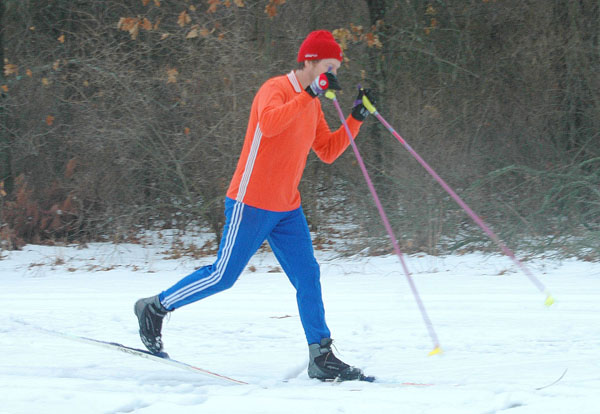
pen 4
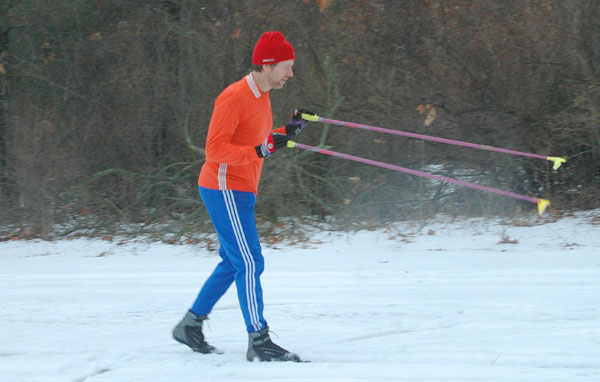
pen 3
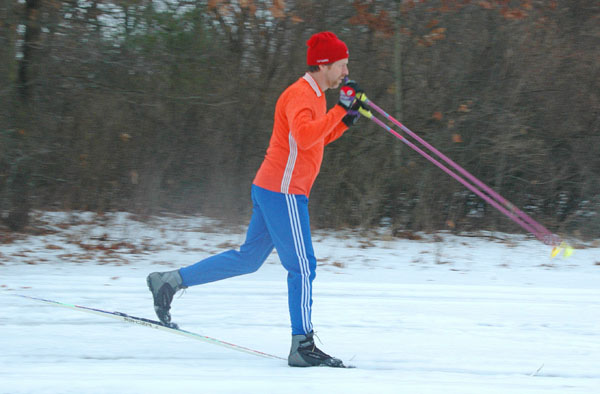
pen 2
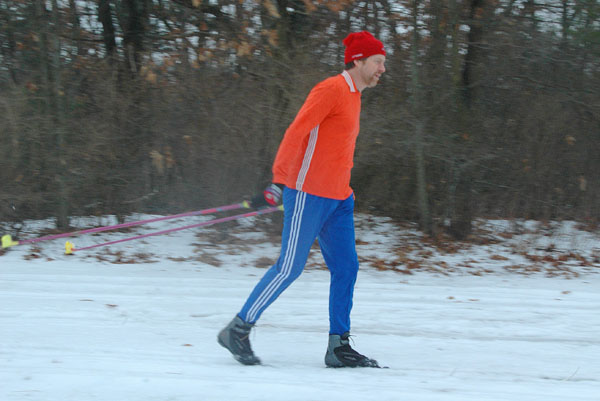
Pendulum Striding Doublepole (or, Three Step)
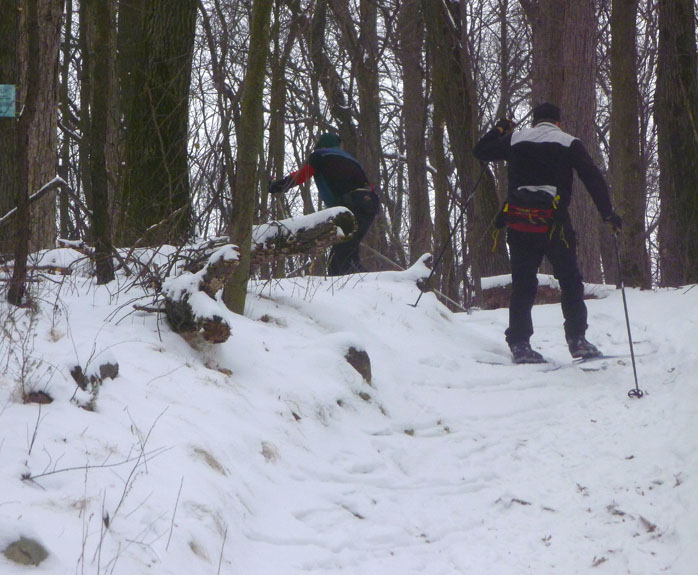
Skidaddle up that hill!
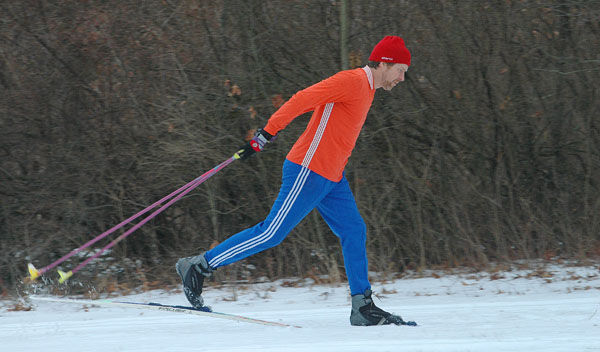
SDP 4
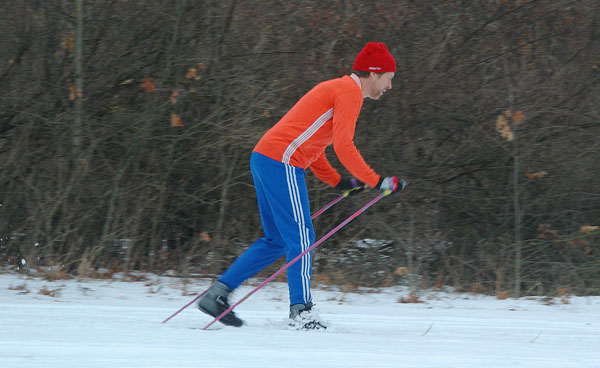
SDP 3
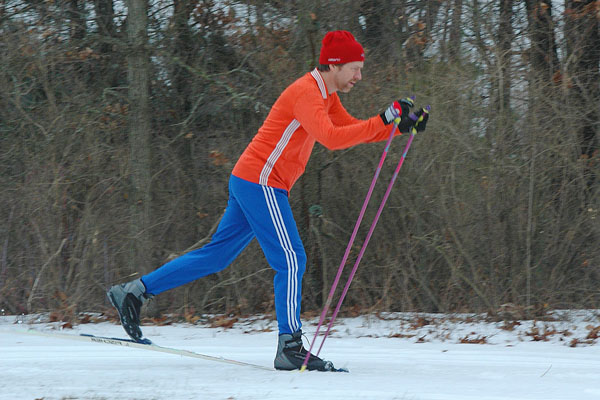
SDP 2
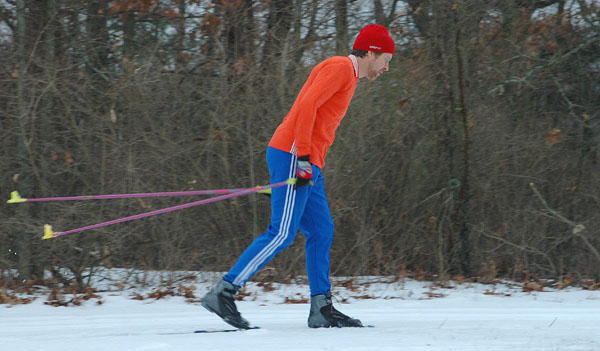
Striding Doublepole — commence!
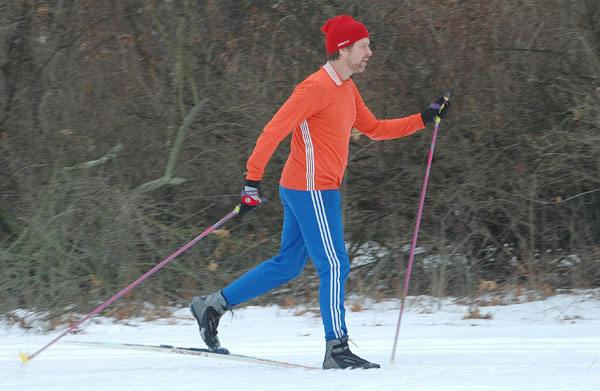
Striding finish — easy! Who cares if the ski slaps.
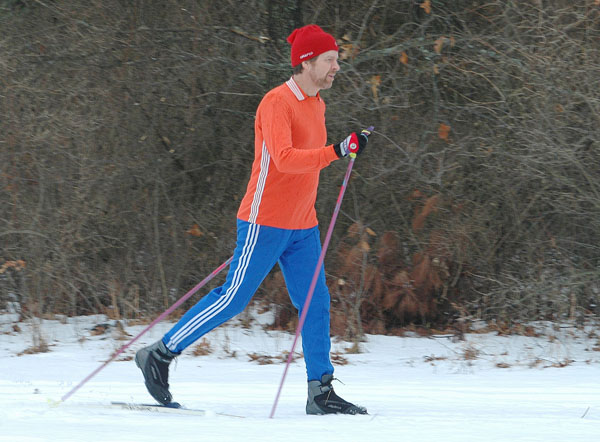
Touring Stride. Nothing special — just breaks all the rules. Good for sightseeing, soft trails, carrying a pack. It’s upright and has a weaker, delayed kick — nice for the flats.
